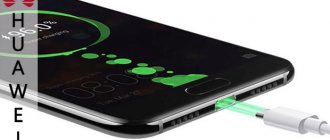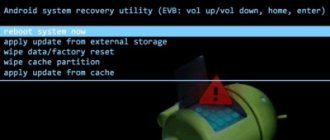If a problem prevents your phone from booting, you can restore factory settings by using recovery mode. This can usually be done by holding down the power and volume up buttons at the same time. The exact sequence of actions depends on the specific device.
If your smartphone freezes or simply stops responding to commands, a reboot will save you, which is enough to solve most problems, although sometimes you have to do a factory reset. After reading this article, you will learn how to perform both procedures.
How to reboot Android
It happens that the smartphone freezes for no obvious reason - it’s annoying, of course, but usually this does not lead to big problems, and the situation can be solved very simply: the phone starts again.
To reboot a frozen phone, simply press the power button and hold it for 30 seconds . Agree that this is a fairly simple procedure. However, it may turn out that the roots of the problem go deeper. In this case, it is necessary to resort to a more radical measure - restoring factory settings, after which the following will be deleted:
- Contacts,
- Messages on Whastapp,
- Installed applications
- Media (music, photo and video),
- System and application settings.
Warning
Warning
First things first, let's get this out of the way. Performing a factory reset on Android will erase all your data and restore the software to its original state. This means that all apps and data stored on your device will be deleted. Be sure to back up all important files and data before proceeding. We have a guide on how to backup an Android phone, linked below.
Actually link : How to backup an Android phone
How to restore factory settings
So, rebooting didn't help. It's worth trying to roll back the settings to factory settings. It sounds complicated, but in fact it’s simple. The fastest and safest way is to do this through the Settings menu. If it is not available, a reset is performed using recovery mode. Let's talk in more detail about both methods.
Attention! The last procedure will delete all data. Before taking any action, copy your personal information (contact list, images, videos, documents) to a third-party data storage facility, preferably a cloud one. If necessary, use a USB cable to connect to your computer.
Reset via Settings menu
Attention! This procedure will delete all personal files (such as photos and messages). Make sure that all important data has been transferred to backup storage.
The exact sequence of actions may vary depending on the device model, but in general terms you need to do the following.
In the “Settings” menu, find the “Backup and reset” item, select “Reset phone settings” and enter the password if you have set one previously. You will be prompted to erase all data. Confirm this action and wait for the process to complete, after which you can use the backup data storage to restore previously saved information.
The whole procedure will take no more than a few minutes.
Reset with buttons via recovery mode
If your phone is frozen, the touch screen isn't working, and you can't seem to get to the settings menu, don't give up hope. There is a solution: Android can be put into recovery mode using the buttons on the case.
Below is a list of commands that work on devices of some popular brands. If you don't see your phone brand listed, just do a Google search for "master reset" and the device name. It is better to press the power button after you have pressed the other buttons.
- Samsung: Volume Up, Home Button, Power.
- Google Nexus/Pixel: volume down, power.
- HTC: volume down, power. On some HTC models, you need to hold down the volume after you release the power.
- Motorola Moto Z/Droid: volume down, power. Most Motorola devices require you to hold down the volume down button and press (once) the power button.
- LG: volume down, power. When the LG logo appears, release the power and immediately press again. Hold the Volume Down button.
- Sony Xperia: volume down, power.
- Asus Transformer: volume down, power.
Don't be surprised that getting into recovery mode is so difficult. This is not to confuse you. Manufacturers just want to make it impossible to accidentally put the smartphone into recovery mode, because in this case it would be very easy to erase all data from the device without meaning to.
So, first, turn off your phone. After that, press and hold the Volume Down button, then press the Power button until it turns on again. “Start” should appear on the screen.
Once in recovery mode, use the volume buttons to select the desired command. It usually contains the words "wipe" or "delete". Sometimes - “perform factory reset”. The specific formulation depends on the manufacturer. To select a command, the on/off button is most often used as an analogue of the computer “Enter”.
Now hold down the Volume Down button until “Recovery mode” appears.
After that, press the Power button to get into recovery mode. You will see the Android logo. Once the phone is in recovery mode, press the Power button and Volume Up once. After that, release the Power button.
Now press the Volume Down button until a menu appears on the screen.
The available options may vary depending on the device model, but there are certain standards that are always available.
- reboot system now - will reboot the device in normal mode.
- apply update from ADB - allows you to connect your phone to your computer via a USB cable and send commands to it using the Android SDK.
- wipe data/factory rest - will delete all data and return the phone to its factory state.
- wipe cache partion - will clear the cache partition. This is temporary system data associated with app installations, and you can delete it without losing any personal data. This can solve many problems.
Note: Starting with Android 7.1, Google removed the last item. You can do the same by going to Settings → Storage and selecting Cached Data.
As you already guessed, in this case you need to select the “Wipe data/Factory reset” item.
The system will ask if you really want to delete all data - select “Yes” using the volume buttons.
Now you need to select “Reboot system now”.
After this, Android will begin resetting the settings. When everything is over and the system boots, use backup storage to restore data.
Rebooting Android TVs
As you know, any Android device requires a reboot from time to time to ensure smooth operation. Over time, they become bloated with redundant files and data, all of which cause them to run slower. Performing a factory reset removes any buildup and restores the device to its original factory condition. This means it should work just like new.
To perform a factory reset on TVs, you will need a Toothpick keyboard and USB, especially if the remote control is not working. Follow these steps:
- Disconnect the device from power.
- With the power off, place the pin into the AV or SPDIF port on the back of the box. If you press gently, you will feel a small button.
- Press it lightly until it feels pressed.
- While holding the button, turn the power back on.
- Continue holding the button until the logo appears.
- When this happens, she is released.
- The TV immediately goes into startup mode.
- Move to the final stage.
- If this does not happen, the user will be taken to another screen that will ask how to boot the device. A menu should appear.
- Using a USB keyboard, press until reset mode is highlighted.
- Press tab on your keyboard.
- Select to delete all user data.
- Wait for the process to complete, select the reboot device and press tab.
- After reboot, provide your login credentials.
Factory reset protection
Every device running Android 5.0 Lollipop or later has Factory Reset Protection (FRP) enabled by default. This means that you will be required to enter the username and password for your Google account, even after a full factory reset. If you don't have this data, the phone will remain locked and you won't be able to access it.
This is done in order to reduce the number of thefts, since even a factory reset via the recovery menu will not give the thief access to your data. It's also worth remembering that if you plan to delete all data from your phone before selling it, to avoid FRP protection, be sure to go to Settings → Accounts and delete your Google account before performing the reset. If there is more than one account registered, make sure you delete them all.
Using a computer
Resetting settings on Android to factory settings is done through programs that need to be installed on the computer. Each manufacturer of smartphones, tablets and other Android devices has different software:
- For the EMUI shell (Huawei, Honor) - the program is called HiSuite.
- For Samsung models with Android version 4.3 and higher - Smart Switch.
- For the MIUI shell from Xiaomi, this is Mi PC Suite.
There is also a universal ADB debugger that allows you to roll back to the original settings of a device connected via a computer. To configure it:
Step 1. Install the ADB utility, which is included in the Android SDK (at the bottom of the page, archive 148 MB).
Step 2: Download the Java Development Kit for your operating system, then install the package.
Step 3. Enable the USB debugging function (you can immediately, in the smartphone settings), you can do it once, when connecting to a computer via USB.
Step 4: Now open the SDK – “tools” folder and run the “Android” file.
Step 5. Select "Android SDK Platform-tools" and click "Install 1 Package".
Step 6. Accept the license terms and click “Install”.
Step 7. Once the installation is complete, “platform-tools” will appear in the “sdk-tools-windows-version” folder, in which ADB will be located.
When connecting your smartphone, make sure that USB drivers for the devices are installed and Windows recognizes them normally.
To activate the hard reset mode, do the following:
Step 1: Connect your Android gadget to your computer and open the folder containing the ADB file. Shift+RMB on an empty space in the folder and select “Open PowerShell window here.” In the window, enter the command .\adb reboot bootloader and execute using Enter.
Step 2: Then press fastboot –w or fastboot erase userdata to erase data from your smartphone.
Step 3. Reboot your device using the fastboot reboot command.
If you encounter problems installing ADB from an official source, you can use the alternative ADBDRIVER bootloader, which includes all installation steps.
The illusion of data deletion
When you do a factory reset, in theory, everything should be completely removed, but this is not entirely true. Android removes the addresses of all your data from its memory, so it no longer knows where it is and cannot show it, but it actually remains in flash memory. Therefore, someone can use special programs to recover deleted files to get them back. Let's see how we can avoid this.
Encrypt your data
The first option is to encrypt the data. This functionality is already built into Android and requires you to enter a PIN code or password every time you unlock the screen. Anyone who tries to recover data from your phone will need a special decryption key, which they don't have.
The exact path to this feature may vary slightly, but it is usually located in the Settings → Security → Encrypt Data menu. But on a Samsung Galaxy, for example, you need to go to the following path: “Settings → Lock screen and security → Encrypted data protection.” There's also the option to encrypt the SD card, but if you're selling the phone, we recommend simply removing it instead.
If you already have Android 6.0 Marshmallow or higher installed on your phone after purchase, it should be encrypted by default and you can move on to the next step. If you don't know what version of Android you have installed, go to Settings → About device → Software information. Keep in mind that by default it will only be encrypted if Android 6.0 Marshmallow was installed out of the box.
Overwrite with unnecessary data
If you want to be absolutely sure, you can overwrite the encrypted data with unnecessary data and then perform a factory reset. Then it will be truly impossible to recover your old data. If you want to do this, just download various junk onto your phone until the storage is full - a few large videos should do the trick. Then reset again one more time.
You can also do this using applications from the Google Play Store, for example, iShredder 6. It can fill free disk space with various “garbage”, securely delete application cache or individual files and folders.
Reset with buttons via recovery mode
This function will be needed by those people whose gadgets do not work due to a failure in the update process or other software problems. It will also help if the cause of the problem is a virus.
First of all, you need to determine how to activate this mode on the device you are using. Possible combinations with the power button:
- increase volume;
- volume reduction;
- both volume keys.
For most smartphones, you need to turn off the gadget and then simultaneously lock the indicated buttons. For some devices, for example those released by Motorola, this function can only be called from bootloader mode.
More complex options may also occur. For example, on LG devices you need to hold down the combination of the power and volume down keys, release both when the logo appears, and then repeat the action.
The key combination depends not only on the manufacturer, but also on the specific model. Therefore, on some gadgets from this company, you only need to release the power, and the volume control must be held continuously. The transition to this mode is made as difficult as possible to prevent the risk of accidentally pressing the required combination.
When the device is transferred to the required state, you need to follow the following instructions:
- select Wipe data / factory reset;
- if the model supports the function of resetting settings without deleting multimedia files on the gadget and completely clearing data, click on the desired option;
- confirm the action.
If the phone screen does not respond to attempts to select the required menu section, you can use the buttons located on its body to reset the device. In this case, they act as analogues of the cursor and Enter on a computer. Use the volume keys to move around, and press the power button to confirm your selection.
Why do they resort to this procedure?
- One of the reasons to use this option is to remove confidential information, for example, if you are selling your phone to someone else and do not want any information about you to remain. In case of theft, this method will not work, but you can use the option to remotely control your device to erase data immediately after turning on the phone.
- Another reason why settings are reset is the appearance of errors and problems of a system and software nature.









